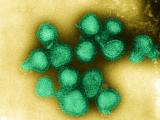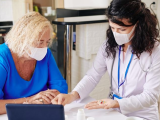(CIDRAP Business Source Osterholm Briefing) - More than 4 years ago, CIDRAP recognized the vital role businesses would play in protecting their employees and keeping critical products and services available during a pandemic of potentially dire consequences.
We launched an ambitious enterprise to help businesses and employers prepare for infectious disease threats and, in particular, to advance private-sector readiness for an influenza pandemic that we knew would inevitably emerge. The CIDRAP Business Source became our answer to addressing this important public health need, and since November 2006, we:
- Built and improved upon a Web site deep with resources
- Published nearly 30 issues of the CIDRAP Source Weekly Briefing (our initial multi-page PDF format)
- Published 72 issues of Osterholm Briefing
- Published nearly 100 issues of Osterholm Briefing Update
- Hosted three summits (in 2006, 2007, and 2009) that brought together infectious disease experts, top government public health officials, human resource and healthcare professionals, and important private-sector decision makers to ensure one goal: Keep the world working during the first influenza pandemic of the 21st century
- Hosted 10 webinars
- Released three reports on the pandemic threat to the nation's power supply, human resource issues during a pandemic, and key themes from the 2009 summit
- Completed a 5-month business needs assessment on behalf of the Centers for Disease Control and Prevention (CDC) and made recommendations on how to align public health goals with business and employer priorities
The time has come, however, to transition CIDRAP Business Source. Our subscription-based business model has surely been challenged by a prevailing notion that "the influenza pandemic of the decade" is done for the next 10 years or more. True, the 2009 H1N1 pandemic has been declared over. But the emergence of another pandemic remains a threat.
Like you, we've had to make some tough decisions about the future of pandemic preparedness. And so we will be concluding our weekly newsletters and transitioning the Source Web site (www.cidrapsource.com) into a publicly available resource that will soon become integrated into the original CIDRAP Web site (www.cidrap.umn.edu). (If your paid subscription ends after May 31, 2011, you will automatically receive a prorated refund via check.)
Have we fulfilled our mission?
Yes and no.
Has CIDRAP Business Source offered practical information that provided context and facilitated decision-making? Yes. I believe we did, especially during the hectic early days of the 2009 H1N1 pandemic. And we were able to do so with help from many sources, including an outstanding editorial board of business, public health, and preparedness professionals, all of whom shared our deep conviction to help organizations of all sizes prepare for a pandemic of dire consequences.
Are businesses and employers fully prepared for a pandemic they consider a threat on par with the 2010 oil spill in the Gulf of Mexico or the earthquake/tsunami/nuclear disaster in Japan this year? No. We are only in the early stages of true readiness.
Not the pandemic we expected
It's clear that the 2009 H1N1 pandemic registered for most organizations as an inconvenience, but not as a disaster. For organizations that invested in pandemic planning, the H1N1 experience could be considered an exercise in real time that allowed them to get a baseline understanding of operating during one kind of pandemic. But in no way did it fully test the capacity of businesses and employers to weather the "Katrina," "Fukushima," or "Deepwater Horizon" of pandemics.
But I'll bet your C-suite doesn't consider the emergence of another pandemic as likely at all in the next 5 or even 10 years. And that worries me. Here's why.
If we've learned anything from the past decade, isn't it that if we've seen one disaster, we've seen one disaster?
Remember Hurricanes Alison (2001), Isabel (2001), or Ivan (2004)? Did the experience and lessons learned with those natural disasters ensure that oil-producing states along the Gulf Coast could handle the likes of Hurricane Katrina or Rita in 2005? And how about Hurricane Ivan's damage to Taylor Energy wells in 2004? Reports emerged last year that the wells were still leaking. Did lessons learned from that accident prepare us for the aftermath of a spill like the 2010 Deepwater Horizon mess? Along that line of reasoning, I have to ask: Can we in good faith use our experience with the 2009 H1N1 pandemic to gauge the impact of the next pandemic, or to predict when it will unfold?
The answer is, of course, no.
We understand this well at CIDRAP, and that's why we're preserving the resources we worked so hard to gather and vet for you—and making them public, thus allowing access for businesses and employers previously unable to take advantage of the excellent information available there. It's also why we are dedicated to providing some of the finest infectious disease news reporting available in the United States, through CIDRAP News. I strongly encourage you to subscribe to our free daily news reports and to stay in close
I also encourage you to stay connected to the CDC. The CDC's influenza coordination unit demonstrated an extraordinary commitment to helping businesses become and stay prepared for the next influenza pandemic. And we know the CDC has listened carefully to your H1N1 experience and is aware of what it will take to align public health priorities and business realities. We hope you bolster the agency's efforts to support you by making known your organization's stance on how well the CDC is funded. This is no time to shrink the capacity of this critical public health agency.
Many thanks
Allow me to recognize a few people who've worked "behind the curtain" to make CIDRAP Business Source possible:
- The Alfred P. Sloan Foundation generously provided the critical start-up support for this effort, and without its help the CIDRAP Business Source would have never existed.
- John Finnegan, PhD, dean of the School of Public Health at the University of Minnesota, provided the critical seed money and support to begin this venture.
- We counted on Deputy Editor Peter Sandman for everything from excellent, accessible content to feedback on ideas to conference calls at all hours as the 2009 H1N1 pandemic emerged.
- We turned to Associate Editor Jeanne Denz, director of global benefits for General Mills, for "in the field" reality checks.
- Aaron Desmond, now CIDRAP's associate director of outreach and development, built the business from the bottom up.
- Dr. Nick Kelley, who was a master's student when we began, assembled and vetted the resource-rich Web site.
- Graphic artist Nancy Wester gave us our crisp, clean design.
- Editorial Director Jim Wappes ensured that all content you read was fact-checked, logical, sensible, and free of grammatical errors.
- Members of the Source Editorial Board gave generously of their time to attend conference calls, present at webinars and summits, and participate in key informant interviews about a range of topics. Though the board has been dissolved, we plan to keep their names on the "About Us" page for a time in recognition of their contributions.
- Last, but not least, Managing Editor Kathleen Kimball-Baker oversaw the development of the subscriber Web site and each of the weekly publications. Her expertise, drive, and versatility were essential to delivering on our mission. Her commitment to the service has been extraordinary, as she at times worked around the clock to ensure subscribers received the best and most timely information.
I want to acknowledge all these organizations and individuals, for without their support the CIDRAP Business Source would have never been born or served its useful purpose during the pandemic.
On behalf of the staff at CIDRAP Business Source, let me express my gratitude for subscribing to and using the resources available through our business/public health partnership. It's been an honor to serve you.
May you continue your important work in good health!



















